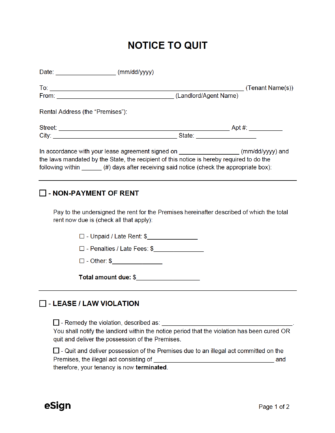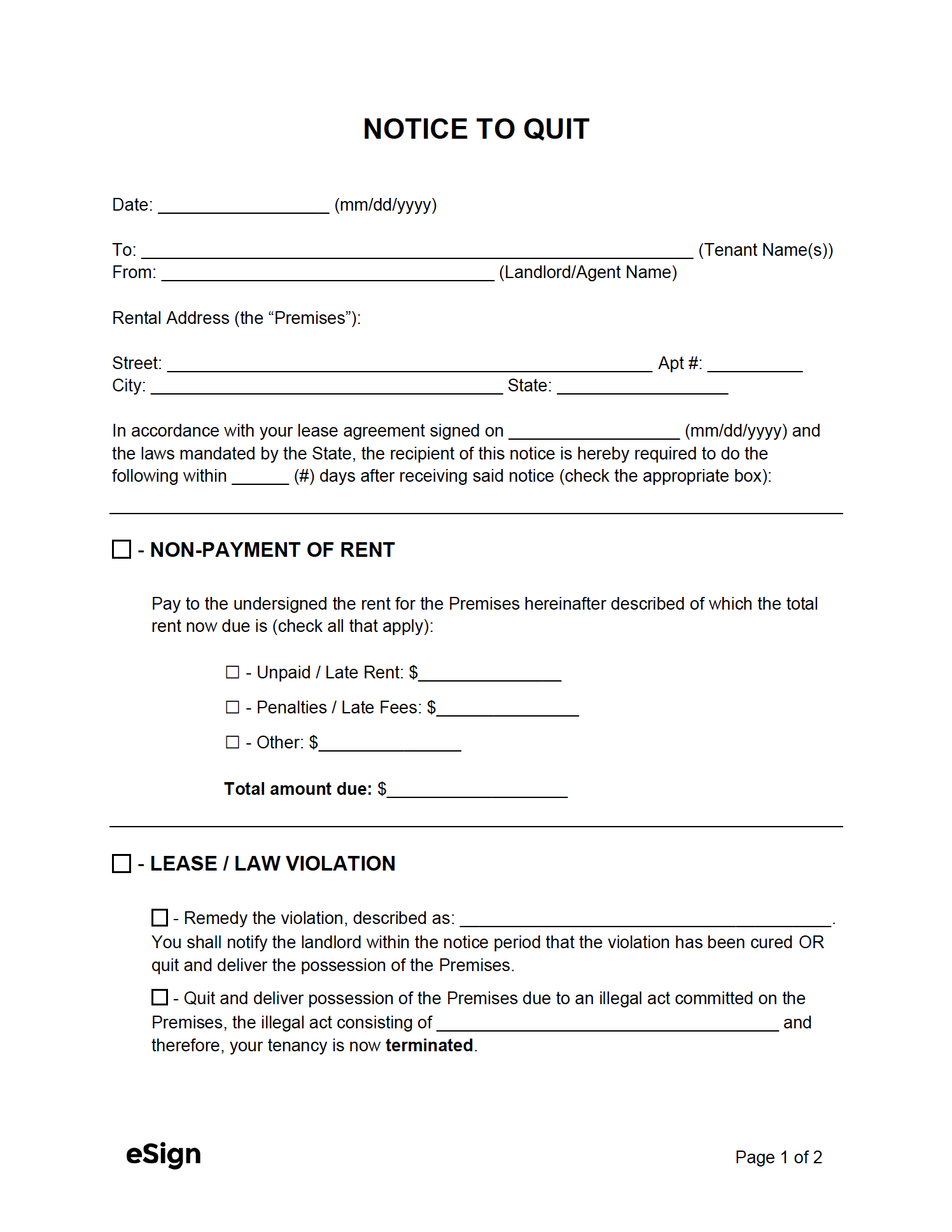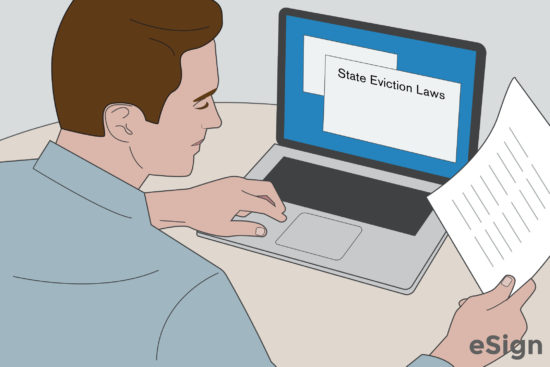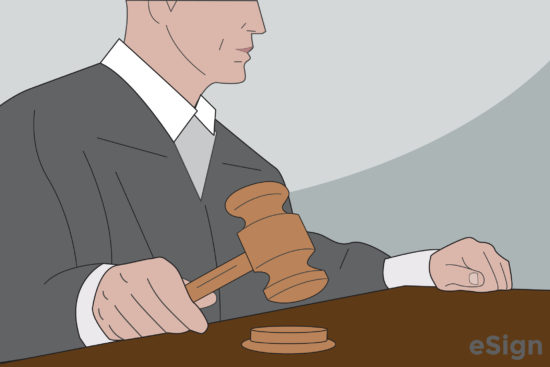Summary
- Used for addressing missed rent payments, lease violations, illegal activity, and for terminating rental agreements (when no violation has occurred).
- Landlords must wait a specific number of days before evicting after sending a notice (see requirements).
By State
- Alabama
- Alaska
- Arizona
- Arkansas
- California
- Colorado
- Connecticut
- Delaware
- Florida
- Georgia
- Hawaii
- Idaho
- Illinois
- Indiana
- Iowa
- Kansas
- Kentucky
- Louisiana
- Maine
- Maryland
- Massachusetts
- Michigan
- Minnesota
- Mississippi
- Missouri
- Montana
- Nebraska
- Nevada
- New Hampshire
- New Jersey
- New Mexico
- New York
- North Carolina
- North Dakota
- Ohio
- Oklahoma
- Oregon
- Pennsylvania
- Rhode Island
- South Carolina
- South Dakota
- Tennessee
- Texas
- Utah
- Vermont
- Virginia
- Washington
- West Virginia
- Wisconsin
- Wyoming
By Type (4)
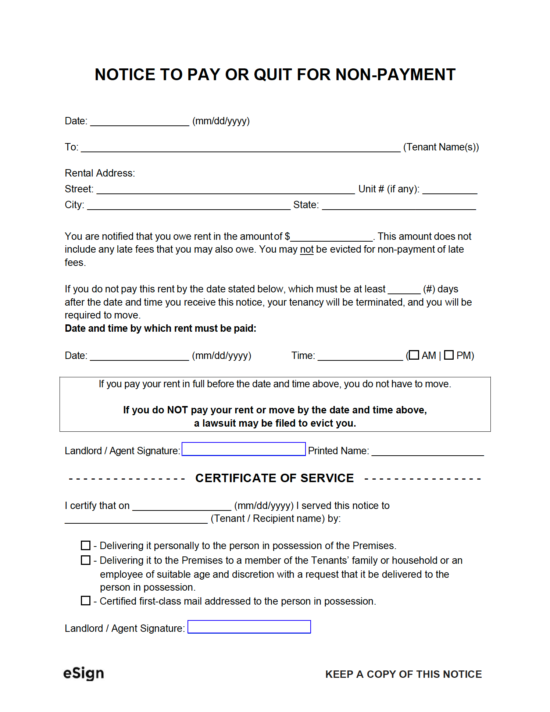
Download: PDF, Word (.docx), OpenDocument
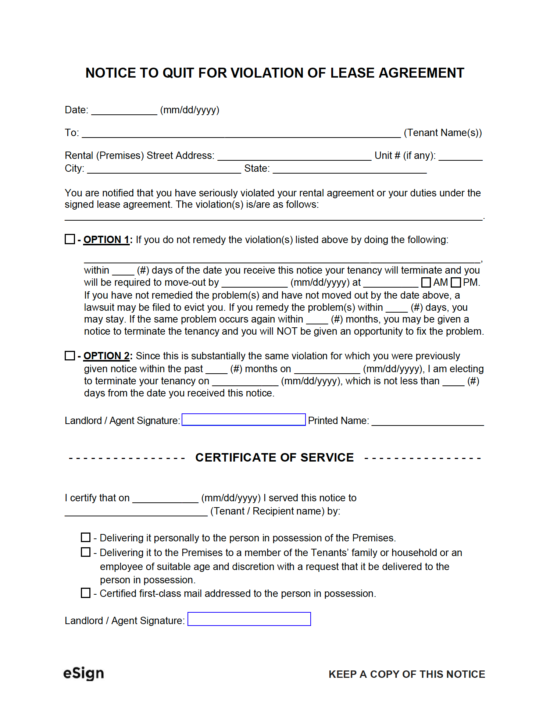
Download: PDF, Word (.docx), OpenDocument
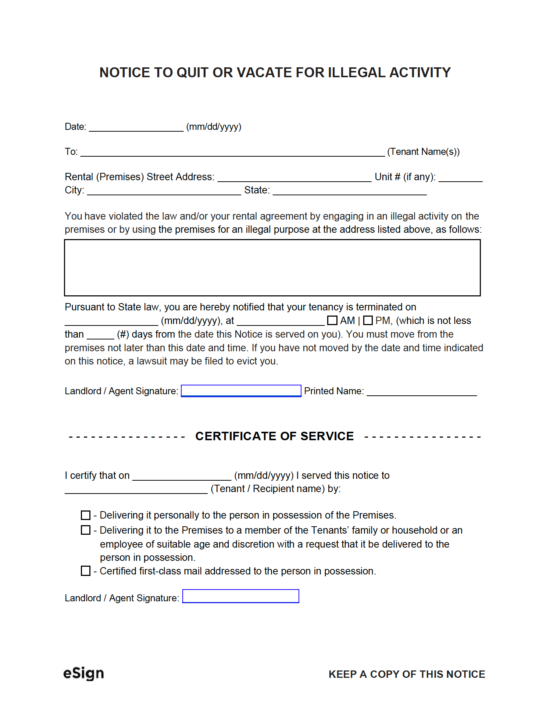
Download: PDF, Word (.docx), OpenDocument
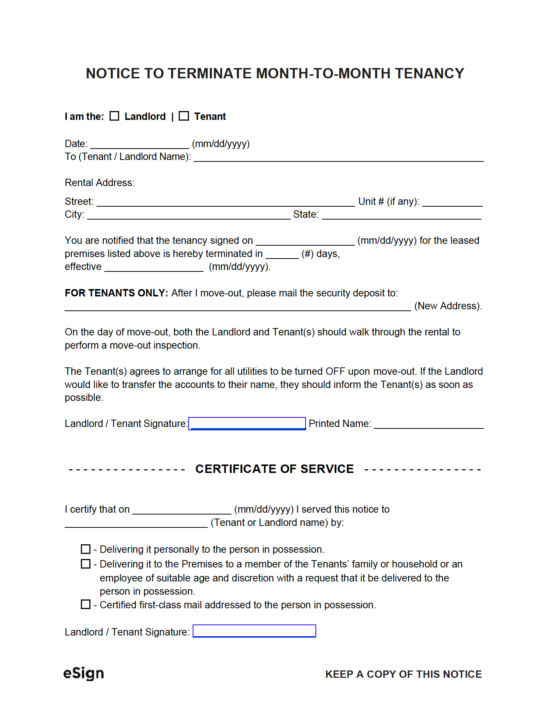
Download: PDF, Word (.docx), OpenDocument
Contents |
What is an Eviction?
An eviction is a type of lawsuit (also called an “unlawful detainer”), whereby a tenant is legally removed from a rental property due to a breach of their lease. The keyword here is “legal,” as a landlord cannot evict a tenant unless they have a valid reason for doing so. Common reasons for eviction include the following:
- One (1) or more missed rental payments.
- Violating the lease (e.g., unauthorized pets, loud noise).
- Purposeful damage to the rental or surrounding premises.
- Illegal activities are conducted in or near the rental.
How to Evict a Tenant (7 Steps)
- Step 1 – Understand State Eviction Laws
- Step 2 – Speak with the Tenant
- Step 3 – Deliver an Eviction Notice
- Step 4 – Wait the Necessary Time (The “Cure Period”)
- Step 5 – File the Eviction in Court
- Step 6 – Go to Court
- Step 7 – Move the Tenant Out + Recover Costs
Evicting a tenant is rarely easy. However, the more prepared a landlord is, the better their odds of having the ordeal end in their favor. The following steps provide an overview of the eviction process:
Step 1 – Understand State Eviction Laws
Each state has its own unique eviction laws. While some go into greater detail than others, many of them cover the required notice lengths that must be given in eviction letters before beginning the court process of legally removing the tenant.
More information on each state’s laws can be found below.
It’s very important the landlord knows that they have the legal grounds to evict the tenant. If the landlord is providing a rental that is uninhabitable, for example, many states permit the tenant to withhold rent payments until the problem is remedied.
Step 2 – Speak with the Tenant
In the majority of cases, heading to Step 3 and delivering an eviction notice is the recommended course of action. However, for tenants that have routinely made rental payments on time, treated the rental with respect, and followed all conditions of the lease up to this point, landlords should give them a chance to explain their situation. The landlord will be able to better understand why the tenant was late on rent, how soon they can make the payment, and remind them of the consequences (eviction notice) that may occur if they don’t make the payment soon.
Regardless of the tenant’s answer, the landlord needs to remain steadfast in their decision. During their conversation, they need to give the tenant two (2) options:
- Pay off the rent immediately, or
- Leave the rental ASAP.
The tenant needs to understand the consequences in the event they don’t comply with either option. An eviction would severely damage their credit score, cause them to be sued to collect rent or damages, and severely hamper their ability to enter into a lease in the future. If they leave or pay the rent, the process stops here. If they continue living in the rental without fixing the issue, the landlord can proceed to the next step.
Step 3 – Deliver an Eviction Notice
If the tenant is hard-set on staying in the property after being told they will be evicted, the landlord will need to deliver an eviction notice to the tenant. To do this, select the state from the list above that corresponds to the one where the property is located. Then, select the form type that matches the situation. As an example, if the tenant is refusing to pay rent, the state may require landlords to provide a minimum of seven (7) days of notice prior to starting the process.
A major step in the eviction process is ensuring the landlord has proof that the tenant received the notice or that a legitimate attempt was made to provide the tenant with notice of their lease violation. Landlords can typically use the following methods for delivering the notice:
- Certified Mail (Best Option) – A process provided by the USPS; certified mail gives landlords proof that a delivery attempt was made to the tenant. This is done by providing the landlord with a mailing receipt, electronic verification, and signature proof (if requested). After delivery has been made, landlords will receive the receipt, which they can later provide to the judge to prove that adequate notice was provided.
- Hand-delivering to Tenant – Issuing the notice personally to the tenant by knocking on their door is a valid way of informing them of their breach of contract. The tenant should sign the notice in front of the landlord to serve as proof they received it.
- Posting to Front Door – Although some states provide landlords with this option, it should be avoided due to the difficulty in proving the tenant received it. Posting the notice to the front door in addition to sending it via certified mail is recommended.
Step 4 – Wait the Necessary Time (The “Cure Period”)
Once the notice has been delivered, the situation falls into the tenant’s hands. As long as the eviction is curable, the tenant can use the number of days mentioned in the letter to remedy the situation. The tenant can remedy the situation by making all outstanding payments (fees included), fixing damages, paying for missed utilities, or fixing another violation as stated in the notice. In the event the tenant ignores the notice and doesn’t comply with what is stated in the form, the landlord should proceed to the next step.
Note on curable and incurable leases: If the notice is incurable, the tenant cannot remedy the situation. They have no other option but to vacate the rental in the time provided. Landlords issue incurable evictions when the tenant has committed the same violation previously, broken the law on the premises, or committed a similar act.
Step 5 – File the Eviction in Court
If the tenant is still residing on the property and the issues have gone unfixed, a complaint will need to be filed in the local courthouse (for a filing fee). Once the landlord has successfully filed, the tenant will be given a summons to appear in court.
Where to File?
The courthouse in the county/jurisdiction where the rental property is located.
What to Bring?
The importance of being prepared can’t be understated. Landlords should bring the following documents/information with them to the courthouse:
- A signed copy of the lease agreement.
- Official notice(s).
- Emails or other forms of communication that took place via SMS, Skype, WhatsApp, etc with the tenant;
- Statements from neighbors.
Filing Fees
Landlords may need to pay fees anywhere from $30 to $150 depending on the court in which they are filing the eviction suit. Because court fees change frequently, landlords should head to the applicable court website to view the most up-to-date filing fees.
Step 6 – Go to Court
Prior to arriving at the courthouse, the landlord should ensure they have all the necessary documentation to prove that the eviction suit is justifiable. Generally speaking, the more information they have the better, but the following items and information should be brought at a minimum:
- Any and all records of payment.
- A copy of the written notice sent or delivered to the tenant.
- Signed lease agreement.
- Any bounced checks.
- All records of communication between the tenant and landlord (texts, emails, messaging apps, etc.)
As an overview, landlords have two (2) main goals during the eviction process: (1) to prove the tenant violated the lease and (2) that they didn’t break any laws during the process.
Be prepared: The most common defenses tenants bring up during the eviction process are:
- Improper notice – a claim that the landlord did not give the tenant enough time to remedy the issue.
- A retaliatory eviction – states that the landlord evicted the tenant to seek “revenge.” For example, they may evict them out of spite because the tenant informed the government of violations the landlord was making.
- Partial rent – if the landlord agreed to accept partial rent from the tenant, their right to eviction is commonly foregone.
- Unmaintained premises – landlords are legally required to provide a habitable rental (and surrounding premises) for tenants.
Step 7 – Move the Tenant Out + Recover Costs
In the event the landlord wins the eviction, they will receive a writ of possession from the judge. This gives the landlord the legal right to acquire the property from the tenant in a certain number (#) of days. It’s during this time the tenant should be actively packing up and moving from the rental.
If the tenant still remains in the property after the deadline stated on the writ of possession, the landlord will need to receive a writ of restitution. This notice will be posted by the local Sheriff’s department giving the tenant a few additional days to vacate the premises. The sheriff/police officer will physically remove the tenant if they remain on the property after exhausting the final deadline.
If the security deposit isn’t enough to cover the damages, the landlord can pursue the tenant in small claims court. If the judge sides in favor of the landlord, they may be permitted to collect the tenant’s wages, their tax refund, or other funds. Note that each state has its own eviction process, and the process may be slightly different than the steps provided here. For more information on the eviction process, select the appropriate state from the provided list.
Required Notice Periods: By State
Depending on the state in which the rental property is located, the landlord may need to provide up to thirty (30) days’ notice to tenants of their pending eviction (unless the tenant resolves the issue). However, some states allow the landlord to commence eviction right away without any notice. “Not specified” means the state does not explicitly cover notice periods regarding non-compliance, which means landlords can provide any notice they deem reasonable.
Grace Periods + Late Fees: By State
Grace periods and late fees come into play when a tenant hasn’t paid the rent by the agreed-upon due date. On one hand, grace periods can be detrimental to landlords because they give tenants the ability to leave rent unpaid until the end of the grace period. On the other hand, late fees are a tool used by landlords to motivate tenants to pay on time. Late fees should never be thought of as a means of getting extra income, but rather as a means of keeping tenants tied to their obligation as stated in the lease.
Note about late fees: In order for landlords to legally charge late fees, the fee must be stated in the signed lease agreement.
| STATE | GRACE PERIOD | LATE FEE | STATUTES |
| Alabama | N/A | N/A | No statute |
| Alaska | N/A | N/A (specified by lease) | No statute |
| Arizona | N/A | N/A | No statute |
| Arkansas | Five Days | N/A | § 18-17-701(b) |
| California | N/A | Fee amount must be justifiable + included in the lease | California Tenants’ Guide (P.30) |
| Colorado | N/A | N/A | No statute |
| Connecticut | Nine Days | N/A | § 47a-15a |
| Delaware | Five Days | Cannot exceed 5% of monthly rent | § 5501(d) |
| Florida | N/A | N/A | No statute |
| Georgia | N/A | N/A | No statute |
| Hawaii | N/A | Cannot exceed 8% of monthly rent | § 521-21(f) |
| Idaho | N/A | N/A | No statute |
| Illinois | Five Days | $20 or 20% of the rent payment (whichever is greater) | 770 ILCS 95/7.10(a & c) |
| Indiana | N/A | N/A | No statute |
| Iowa | N/A | Rent is $700/month or less: Max fee of $12/day or $60/month
Greater than $700/month: Max fee of $20/day or $100/month |
§ 562A.9 |
| Kansas | N/A | N/A | No statute |
| Kentucky | County-specific | County-specific | N/A |
| Louisiana | N/A | N/A | No statute |
| Maine | 15 Days | Cannot exceed 4% of monthly rent | § 6028(1 & 2) |
| Maryland | N/A | Cannot exceed 5% of monthly rent | § 8-208(d)(3)(i) |
| Massachusetts | 30 Days | N/A | § 15B(1)(c) |
| Michigan | N/A | N/A | No statute |
| Minnesota | N/A | Cannot exceed 8% of monthly rent | § 504B.177(a) |
| Mississippi | N/A | N/A | No statute |
| Missouri | N/A | N/A | No statute |
| Montana | N/A | N/A | No statute |
| Nebraska | N/A | N/A | No statute |
| Nevada | Three Days | Cannot exceed 5% of periodic rent | § 118A.210(4) |
| New Hampshire | N/A | N/A | No statute |
| New Jersey | Five Days | N/A | § 2A:42-6.1 |
| New Mexico | N/A | Cannot exceed 10% of periodic rent | § 47-8-15(D) |
| New York | N/A | N/A | No statute |
| North Carolina | Five Days | Cannot exceed 5% of monthly rent or $15 (whichever is greater) | § 42-46(a) |
| North Dakota | N/A | N/A | No statute |
| Ohio | N/A | N/A | No statute |
| Oklahoma | N/A | N/A | No statute |
| Oregon | Four Days | 5% of the periodic rent (can be charged every 5-day period rent goes unpaid) | § 90.260(1 & 2) |
| Pennsylvania | N/A | N/A | No statute |
| Rhode Island | 15 Days | N/A | § 34-18-35(a) |
| South Carolina | N/A | N/A | No statute |
| South Dakota | N/A | N/A | No statute |
| Tennessee | Five Days | Cannot exceed 10% of monthly rent | § 66-28-201(d) |
| Texas | Two Days | Building has 4 or fewer units: 12% of the rent due
Building has 4 or more units: 10% of the rent due |
§ 92.019 |
| Utah | N/A | N/A | No statute |
| Vermont | N/A | N/A | No statute |
| Virginia | Oral agreements only: Five days | N/A | § 55.1-1204(C)(5) |
| Washington | N/A | N/A | No statute |
| West Virginia | N/A | N/A | No statute |
| Wisconsin | N/A | N/A | No statute |
| Wyoming | N/A | N/A | No statute |
How to Evict a Roommate
The To-Be-Evicted Roommate is the Master Tenant
Whether or not a roommate can be evicted depends on the status of the roommate. If the tenant to be evicted is the master tenant, which is the tenant that solely leased with the landlord and essentially “sublet” to the other tenants, they cannot be evicted by the other tenants. With that in mind, explaining the situation to the landlord might influence them to file eviction proceedings against the master tenant and create a new lease with the subtenant using a separate agreement.
The To-Be-Evicted Roommate is a Co-Tenant
If the to-be-evicted tenant is a co-tenant of the other tenant, they cannot start the eviction proceedings themself. In this situation, they would need to inform the landlord of the situation and have them begin the eviction process. Important note: both tenant names would appear on records, even though only one tenant would be the cause of the eviction. The landlord can release the other tenant from liability in this situation.
The Roommate Looking to Evict is the Master Tenant
Finally, if the tenant looking to evict another roommate is the master tenant, they can proceed with proceedings as normal without the landlord’s involvement. In this situation, the eviction process will closely resemble the steps found above.
Requirements & Tips
- Ensure there is a good reason for eviction: Landlords can only evict if they have a legally valid reason, and the same goes for roommates; they can’t evict another roommate for something trivial such as not liking them. Tenants must refer to their state’s laws to ensure the reason for eviction is valid and legal.
- Always remain professional: Maintain composure at all times – while the process can evoke a lot of emotions, the more that is said to the other roommate in anger, the more that roommate can use it against you in court. Additionally, ensure all digital communication is retained, and hold onto any documents and other information that can later be used as evidence against the other tenant.
- Avoid eviction in the first place: Before starting the process, which can be costly and extremely time-consuming, roommates should have a serious conversation about the problems they are having, and how they might be able to solve the issues, or perhaps just move out.
